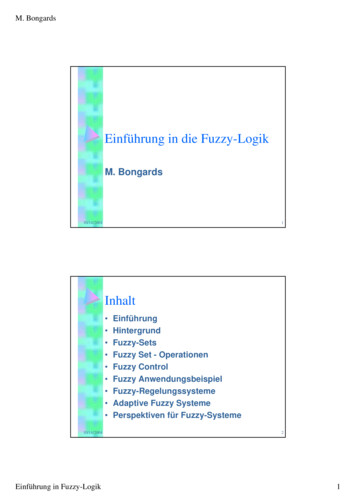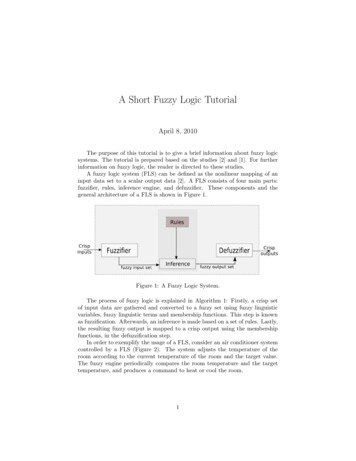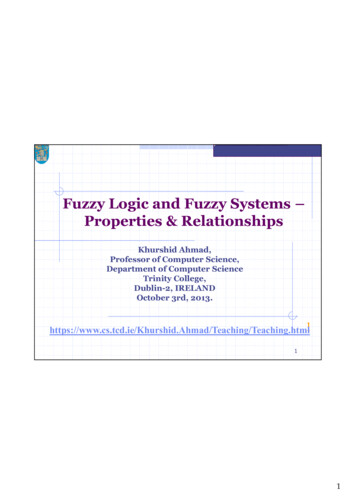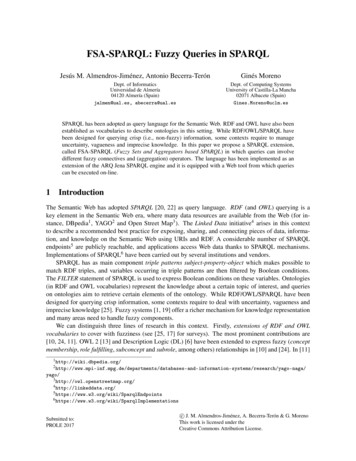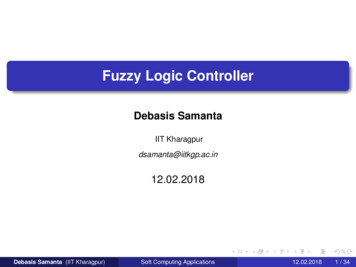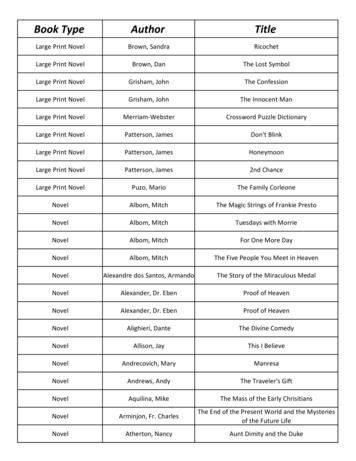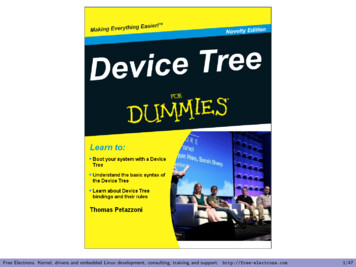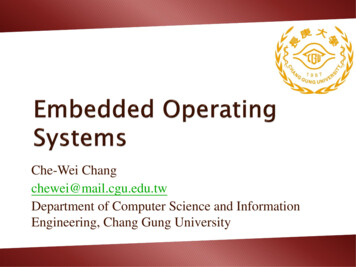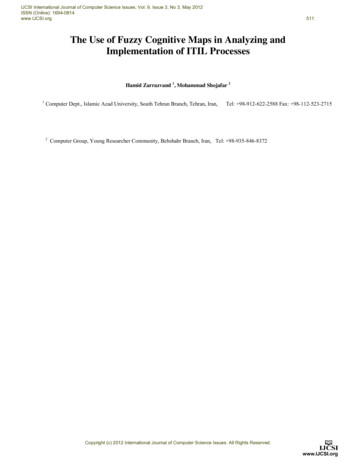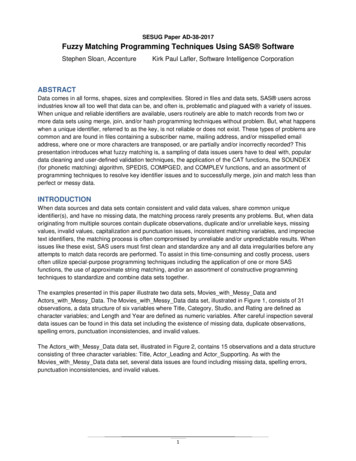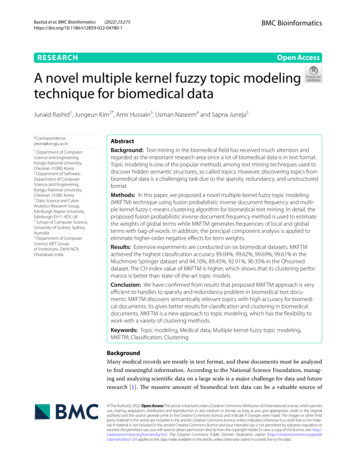
Transcription
(2022) 23:275Rashid et al. BMC 4780-1BMC BioinformaticsOpen AccessRESEARCHA novel multiple kernel fuzzy topic modelingtechnique for biomedical dataJunaid Rashid1, Jungeun Kim2*, Amir Hussain3, Usman Naseem4 and Sapna nt of ComputerScience and Engineering,Kongju National University,Cheonan 31080, Korea2Department of Software,Department of ComputerScience and Engineering,Kongju National University,Cheonan 31080, Korea3Data Science and CyberAnalytics Research Group,Edinburgh Napier University,Edinburgh EH11 4DY, UK4School of Computer Science,University of Sydney, Sydney,Australia5Department of ComputerScience, KIET Groupof Institutions, Dehli NCR,Ghaziabad, IndiaAbstractBackground: Text mining in the biomedical field has received much attention andregarded as the important research area since a lot of biomedical data is in text format.Topic modeling is one of the popular methods among text mining techniques used todiscover hidden semantic structures, so called topics. However, discovering topics frombiomedical data is a challenging task due to the sparsity, redundancy, and unstructuredformat.Methods: In this paper, we proposed a novel multiple kernel fuzzy topic modeling(MKFTM) technique using fusion probabilistic inverse document frequency and multiple kernel fuzzy c-means clustering algorithm for biomedical text mining. In detail, theproposed fusion probabilistic inverse document frequency method is used to estimatethe weights of global terms while MKFTM generates frequencies of local and globalterms with bag-of-words. In addition, the principal component analysis is applied toeliminate higher-order negative effects for term weights.Results: Extensive experiments are conducted on six biomedical datasets. MKFTMachieved the highest classification accuracy 99.04%, 99.62%, 99.69%, 99.61% in theMuchmore Springer dataset and 94.10%, 89.45%, 92.91%, 90.35% in the Ohsumeddataset. The CH index value of MKFTM is higher, which shows that its clustering performance is better than state-of-the-art topic models.Conclusion: We have confirmed from results that proposed MKFTM approach is veryefficient to handles to sparsity and redundancy problem in biomedical text documents. MKFTM discovers semantically relevant topics with high accuracy for biomedical documents. Its gives better results for classification and clustering in biomedicaldocuments. MKFTM is a new approach to topic modeling, which has the flexibility towork with a variety of clustering methods.Keywords: Topic modeling, Medical data, Multiple kernel fuzzy topic modeling,MKFTM, Classification, ClusteringBackgroundMany medical records are mostly in text format, and these documents must be analyzedto find meaningful information. According to the National Science Foundation, managing and analyzing scientific data on a large scale is a major challenge for data and futureresearch [1]. The massive amount of biomedical text data can be a valuable source of The Author(s) 2022. Open Access This article is licensed under a Creative Commons Attribution 4.0 International License, which permitsuse, sharing, adaptation, distribution and reproduction in any medium or format, as long as you give appropriate credit to the originalauthor(s) and the source, provide a link to the Creative Commons licence, and indicate if changes were made. The images or other thirdparty material in this article are included in the article’s Creative Commons licence, unless indicated otherwise in a credit line to the material. If material is not included in the article’s Creative Commons licence and your intended use is not permitted by statutory regulation orexceeds the permitted use, you will need to obtain permission directly from the copyright holder. To view a copy of this licence, visit http:// creat iveco mmons. org/ licen ses/ by/4. 0/. The Creative Commons Public Domain Dedication waiver (http:// creat iveco mmons. org/ publi cdoma in/ zero/1. 0/) applies to the data made available in this article, unless otherwise stated in a credit line to the data.
Rashid et al. BMC Bioinformatics(2022) 23:275knowledge for biomedical researchers. Biomedical texts contain unstructured information, such as scientific publications and brief case reports. Text mining seeks to discover knowledge from unstructured text sources by utilizing tools and techniques froma variety of fields such as machine learning, information extraction, and cognitive science. Text mining is a promising approach and great scientific interest in the biomedicaldomain. These text documents in biomedical require new tools to search for related documents in a collection of documents. Today’s biomedical text data is created and storedvery quickly. Such as, in 2015, the number of papers available on the PubMed websiteexceeded six million. The average record of hospital discharges in the United States ismore than 30 million [2]. Therefore, companies can save annual costs by using advanceddata analysis technology based on machine learning for biomedical text data. Therefore, there is a need to produce efficient topic modeling techniques through advancedmachine learning to discover hidden topics in complex biomedical texts.One way to represent biomedical text documents in natural language processing iscalled the bag-of-words (BOW) model. The BOW model corresponds to the frequencyof words reflected in the matrix of a document collection, and word order in the document does not affect the BOW model. If the document has a vocabulary much shorterthan a matrix, it is called a sparse matrix [3].In text mining, all text corpora are processed, not just biomedical ones. There areseveral text mining applications such as Medline and PubMed. However, because mostbiomedical data is in unstructured text format, analyzing that unstructured data is adifficult task. Numerous text mining techniques are developed for the biomedical datadomain that processes unstructured data into structured data. In the unstructured existence of biomedical text data, topic modeling techniques such as latent Dirichlet allocation (LDA) [4], Latent semantic analysis(LSA) [5], Fuzzy latent semantic analysis (FLSA)[6] and Fuzzy k-means topic model (FKTM)[7] are developed to analyze biomedical textdata. LDA performs better in the classification of clinical reports [8]. LDA is used in avarious applications, including the classification of genome sequence [9], the discoveryof discussion concepts in social networks [10], patient data modeling [11], topic extraction from medical reports [12], the discovery of scientific data and biomedical relationships [13, 14]. The LDA method finds important clinical problems and formats clinicaltext reports in another investigation [15]. In other work, [16] used topic modeling toexpress scientific reports efficiently, allowing the analysis of the collections more quickly.Probabilistic-based topic modeling is applied to find the basic topics of the biomedicaltext collection. Topic process models are utilized in a variety of activities such as computer linguistics, overview for source code documents [17], product review brief opinion[18], description of a thematic revolution [19], discovery aspects of document analysis[20], sentiment analysis [21] and Twitter text message analysis [22]. LSA discovers clinical records from psychiatric narratives [19]. Semantic space is developed from psychological terms. LSA is also used to reveal semantic insights and ontology domains thatare used to build a speech act model for spoken speech [23]. LSA also excels at topicidentification and segmentation in clinical studies [24]. The RedLDA topic model is usedin the biomedical field to determine redundancy in patient information data [25]. Thelatent semantic analysis (LSA) is an automatic analysis of the summary of clinical cases[26]. Topic models are used in biomedical data for a variety of purposes, such as findingPage 2 of 19
Rashid et al. BMC Bioinformatics(2022) 23:275hidden theme in documents and searching documents [27], document classification[28], and document analysis [29]. Topic modeling is an effective way to extract biomedical text, but word redundancy negatively affects topic modeling [30], and since mostbiomedical documents are duplicate words, it still needs improvement [31]. Answering biological factoid questions is a crucial part of the biomedical question answeringdomain [32]. In [33] relationship are discover from the text data.Clustering is a process utilized in the biomedical investigation to extract meaningful information from large datasets. Fuzzy clustering is another way for hard clusteringalgorithms to divide data into subgroups with similar aspects [34]. The nonlinear natureof fuzzy clusters and the flexibility of large-scale data clusters distinguish them fromhard clustering. It offers more accurate solutions for partitioning and additional optionsfor decision-making. Fuzzy clustering is a type of computation based on fuzzy logic,reflecting the probability or score of a data item belonging to multiple groups. Once thedata is partitioned, the centers of the clusters are moved instead of the data points. Clustering is commonly done in order to identify patterns in large datasets and to retrievevaluable information [35]. Fuzzy grouping techniques are frequently used in a varietyof applications where grouping of overlapping and ambiguous elements is required. Inthe biomedical field, some experience has been gathered in diagnosis and decision support systems, where a wide range of measurements is used as the data entry space, anda decision result is formed by suitably grouping the data symptom. Fuzzy clustering isa technique used for various applications such as medical diagnosis, biomedical signalclassification, and diabetic neuropathy [36, 37]. It can also detect topics from biomedicaldocuments and make informed decisions about radiation therapy. Fuzzy clustering hasseveral uses in the biomedical field, especially in image processing and pattern recognition, but it is rarely used in topic modeling. In this study, we presented a multiple kernelfuzzy topic modeling method for biomedical text data. The main contributions made tothis research are summarized below. We proposed a novel multiple kernel fuzzy topic modeling (MKFTM) technique,which solves the problem of sparsity and redundancy in biomedical text mining. We proposed a FP-IDF (fusion probabilistic inverse document frequency) for globalterm weights, which is very effective for filtering out common high frequency words. We conduct extensive experiments and show that MKFTM achieves better classification and clustering performance than latest state-of-the-art topic models includingLDA, LSA, FLSA, and FKTM. We also compare the execution time of MKFTM and shows that its execution time isstable for different topics.Materials and methodWe described our proposed multiple kernel fuzzy topic modeling method that discoverthe uncover hidden topics in biomedical text documents. The two main approachesto clustering are hard clustering and fuzzy (soft) clustering. In clustering, objects aredivided, and each object is a partition. MKFTM handles multi-kernel fuzzy view, aunique method for topic modeling, and validates over various experiment for medicalPage 3 of 19
Rashid et al. BMC Bioinformatics(2022) 23:275Page 4 of 19documents. LDA performance is better for topic modeling, but redundancy alwaysnegatively impacts its performance. Therefore, MKFTM has the potential to deal withredundancy issues and discover more accurate topics in biomedical documents withhigher performance than competitors like LDA and LSA.Multiple kernel fuzzy topic modeling (MKFTM)The documents and words in these document are fuzzy groups in multiple clusters.Fuzzy logic is an extension of the classic 1 and 0 logic to a truth value between 1 and 0.Through MKFTM, documents and words are fuzzily clustered, with each cluster beinga topic. The documents are multi-distribution across topics, and clusters are the topicsin these documents. MKFTM finds the different matrices of probability. The proposedMKFTM are the following steps:Pre‑processingThis step performs a preprocessing of the document input text collection. There is a lotof noise in text documents, such as word transforms, word shape transforms, specialcharacters, punctuation marks, and stop words that add noise. Several pre-processingsteps are used to clean up the text data. The punctuation is removed from the documentcollection. Text data is converted to lowercase and documents are tokenized. After that,short, empty words with fewer characters are removed. Also, the words are normalizedthrough the Porter Stemmer [38].Bag‑of‑words (BOW) and term weightingThe bag-of-words model represents text documents and extracts features from textdocuments for machine learning algorithms. BOW is a systematic method for calculating document words count [39]. After collecting and preprocessing the document’stext, the BOW model is applied. BOW model converts unstructured text data into wordbased structured data, ignoring the grammar in information retrieval [40]. The m documents contain the word k finding the association between words and document. Also,the frequency of k words in documents m is calculated. Equation 1 represent the wordsk frequencies in documents m. The k n means the words k count in n documents. Theni,j means the count of words in matrix i, j . The k j means numbers that the numbers ofwords count in rows. The tf is term frequency.ni,jtfi,j k, jkn(1)Local terms are weighted after applying BOW and the term frequency method isanother local term method. The term frequency [41] evaluate evaluates the frequencywith which the term appears in a document. Because each document is of differentlengths, more terms may appear in longer documents than shorter ones. Equation 2shows a typical weighting term that uses a vector field of normalization coefficients. Theterm weight, which reduces these terms, is essential and assigned wdk that constantlyvaries from 0 to 1. Here, d represents a document, k defines the term and wdk means kterms of d documents in words w. Weight is used in the most important terms and zero
Rashid et al. BMC Bioinformatics(2022) 23:275Page 5 of 19is used in the least important terms. In some cases, the use of a standard weight assignment may be useful, and the weighting term depends on many impacts on the weights,using different terms individually within each vector.wdk(2)2vector (wd i)This shows the weight w of the k term. If a term index ki frequency fi,j appear in thedocument dj , the general frequency Fi of the k terms is well-defined in Eq. 3.Fi Nfi,j(3)(j 1)N is a numbers of document in a large set of text corpus. The frequency of documentterm kiki refers to the number of ni documents occurrence and ni Fi.Fusion probabilistic inverse document frequency (FP‑IDF)The weight of global term (GTW) is estimated at this stage. GTW provide "discrimination values" for all terms. The less frequent terms in document collection are morediscriminating [42]. The tfij symbol determine the number of time word i appears indocument j. The number of documents is indicated by N and ni is total number of documents appearing in the i term. GTW is calculated by finding the b(tfij) and Pij usingEq. 4, 5.1 if tfij 0b tfij (4)0 if tfij 0tfijPij j tfij(5)The b(tfij) and Pij are used to calculate the fusion probabilistic inverse document frequency. We proposed a FP-IDF by combining the hybrid inverse documents frequencyHybrid IDF and probabilistic Inverse documents frequency (Probablistic IDF)for weighting global term. Equations 6 and 7 show the formula for Hybrid IDF andProbablistic IDF.NHybrid IDF logmax(6){t ′ d }nt ′ ntProbablistic IDF logN ntntFusion Probablistic IDF logmax{t ′ d }nt ′(7)Nnt logN ntntUse the product property of logarithms, logb x logb y logb xy.(8)
Rashid et al. BMC Bioinformatics(2022) 23:275Page 6 of 19Fusion Probablistic IDF logmax{t ′ d }nt ′N N ntnt nt(9)Combine max{t′ d}nt′ and nNtFusion Probablistic IDF logMultiplymax{t′ d}n ′ Nnttandmax{t ′ d }nt ′ NN nt·nt(10)max{t ′ d }nt ′ N (N nt )(11)max{t ′ d }nt ′ N (N nt )(12)max{t ′ d }nt ′ N (N nt )(13)ntN ntntFusion Probablistic IDF lognt ntRaise nt to the power of 1.Fusion Probablistic IDF logn1t ntRaise nt to the power of 1.Fusion Probablistic IDF logn1t n1tUse the power rule am an am n to combine exponents.max{t ′ d }nt ′ N (N nt )Fusion Probablistic IDF logn1 1t(14)Add 1 and 1. We proposed a FP-IDF in Eq. 15.FP IDF logmax{t ′ d }nt ′ N (N nt )n2t(15)Principal component analysis (PCA)After the FP-IDF global terms weighting method, the PCA is used. The PCA [43] technique has been used to avoid large-scale adverse effects in the weighting of global terms.This method removes redundant dimensions from the data and retains only the mostimportant data dimensions. The PCA calculates the new variable that refers to the principal component, resulting from the integrated integration of the initial variables.Multiple Kernel fuzzy C‑means clusteringAt this step, the multiple kernel fuzzy c-means clustering algorithm [44] is used for fuzzily group documents, which is represented by GTW method. In multiple kernel fuzzySc-means clustering algorithm B is a data point,Y {Yi }Bi 1, kernel function Gg g 1,numbers of desired clusters are F and output membership matrix V {vif }B,Fi,f 1 withSweight Zg g 1 for kernels. The multiple kernel fuzzy c-means have the following steps:
Rashid et al. BMC Bioinformatics(2022) 23:275Page 7 of 191: Procedure multiple kernel fuzzy c-means MKFCM (Data Y, Clusters F, KernelsSZg g 1)2: Membership matrix initialization V (0).3: Repeatsl 4: v if (l)uicB(l)si 1 vif, Calculate the normalized membership.5: Calculate Coefficients Eq. 16 BBB αifg Gg yi , yi 2v jf Gg yi , yj v jf v j′ f Gg yj , yj′(16)j 1 j′ 1J 16: for (i 1 B; f 1.F; g 1.S) do7:αifg Gg (yi , yi ) 2BBB v jc Gg yi , yj v jf v j′ f Gg yj , yj′(17)J 18: end for9: Calculate coefficient by Eq. 18.10:for (g 1 S) do11:βk BF(l) svif αifg(18)i 1 f 112:end for13: Update weights by Eq. 19.14:for (g 1 S) do(l)15:zg 1βg111β1 β2 ··· βS(19)end for16: distance calculate by Eq. 20.17:for (i 1 B;c 1.F) do18:Tif2 Sg 12αifg zg(l)(20)19:end for20: update memberships Eq. 2121:for (i 1 B;f 1.F) do22:(l)vif Ff ′ 1123:end for24:until Vl V l 1 Dif2Dif2 ′1s 1(21)j 1 j ′ 1
Rashid et al. BMC Bioinformatics(2022) 23:275Page 8 of 19S(l)25:return V (l) , zg.g 126:end procedureProbabilistic distribution of documentsThe document term matrix, along with the GTW method (matrix of words documents), find the probability of a document P(Dj), calculated by Eq. 22. Here i representsthe various documents.m(Wi , Dj )nP(Dj ) m i 1(22)i 1j 1 (Wi , Dj )Probabilistic distribution of the topics for documentsThe probabilities of obtaining the j documents in the k topic are P(Dj Tk ) throughP(Tk Dj) with P(Dj), as described in Eq. 23.P(Dj , Tk ) P(Tk Dj ) P(Dj )(23)Since, finding the P(Dj Tk ), normalized the P(D,T) for each topic through Eq. 24.P(Dj , Tk )P(Dj Tk ) nj 1 P(Dj , Tk )(24)Probabilistic distribution of words in documentsThis step calculates the probability of a word i in the j document applying Eq. 25.P(Wi , Dj )P(Wi Dj ) mi 1 P(Wi , Dj )(25)Probabilistic distribution of words in topicsThe probabilities of word i in topic k P(Wi Tk ) through P(Dj Tk ) and P(Wi Dj) is calculated through Eq. 26.P(Wi Tk ) nP(Wi , Dj ) P(Dj Tk )j 1(26)DatasetsIn this research, we used six state-of-the-art datasets, which are publicly available.The first dataset is a medical abstract of the English scientific corpus from MuchMoreSpringer Bilingual Corpus,1 a labeled dataset. We used two categories of journals,1http:// muchm ore. dfki. de/ resou rces1. htm
Rashid et al. BMC Bioinformatics(2022) 23:275Page 9 of 19Table 1 Datasets statisticsDatasetsDocuments (Preprocess)WordsUnique wordsMuchMore 395,63625,309WSJ1300680 K36 Kincluding the federal health standard and arthroskopie, for experimentation. Table 1shows the statistics of datasets. The medical abstract from MeSH categories from Ohsumed Collection2 is a secondlabeled corpus dataset. The experiments are conducted in three categories: virus disease, bacterial infection, and mycoses. Biotext [45] is the third dataset, containing summaries of diseases and treatmentscollected from Medline. The fourth data set is GENIA corpora [46], abstracts collection from Medline papersdescribing the molecular biology literature. The fifth is the redundant corpus of synthetic WSJ and is generally used in naturallanguage processing (NLP) [47, 48]. The six datasets are health news tweets3 (T-datasets), an unlabeled dataset.ResultsExperimental performedWe performed the classification, clustering, execution time and redundancy issues forexperiments. We used six state-of-the-art datasets for experiments. The first two datasets Muchmore springer bilingual and Ohsumed Collection, are labeled datasets. Therefore, it’s used for classification. The other two datasets Biotext and Genia are unlabeled.Hence, it’s used for clustering. The redundant corpus of synthetic WSJ is used for theredundancy issue comparison because in literature this dataset is mostly consider forredundancy issue. Therefore, we used the same dataset for fair comparison. The execution time is compared to the health news tweets dataset, containing more documents.Experimental setupWe used the laptop core i7 computer with 16 GB RAM and MATLAB software forexperiments.23http:// disi. unitn. it/ mosch itti/ corpo ra/ ohsum ed- first- 20000- docs. tar. gz.https:// archi ve. ics. uci. edu/ ml/ datas ets/ Health News in Twitt er
Rashid et al. BMC Bioinformatics(2022) 23:275Page 10 of 19Baseline topic modelsIn this section, our proposed MKFTM topic model is compared with the state-of-theart LDA [4], LSA [5], FLSA [6] and FKTM [7] topic models. Experiments are performedfor both classification and clustering. We also compare our proposed topic model withRedLDA [25] and FKTM, which are used for redundancy problems.Classification of documentsThe first classification evaluation is performed with Bayesian optimization for two datasets,including MuchMore Springer Bilingual Corpus and Ohsumed Collection. Optimizationrefers to searching for points to minimize functions with real value, known as objectivefunctions. The bayes optimization is a gauss-process objective function model that evaluates the objective functions. Bayesian optimization minimizes cross-validation error. MATLAB fit function is used for Bayesian optimization. MKFTM performance is comparedto LDA, LSA, FLSA, and Fuzzy k-means topic models using a tenfold cross-validationmethod. Document classification is performed on topic probabilities for document P(T D)through discriminant analysis machine learning classifier [49] using Bayes optimization.Discriminant analysis is described in Eq. 27y argminy 1,.KK(27)p(k x)C(y k)kThe y represent the expected classes and k is number of classes. The p(k x) is the posterior probability of class k and observations x. The Cy k is the classification cost and observation y with the true class k . The discriminant analysis classifies the document featureswith different topics such as 50, 100, 150 and 200. MKFTM performance of classification ismeasured using precision, recall, accuracy, and F1-score. Precision, recall, accuracy and F1measurements are used to verify the performance of the MKFTM. The classification resultsof two datasets labeled MuchMore Springer and Ohsumed are shown in Tables 2 and 3.The results of the MKFTM classification are compared with the latest LDA, LSA, FLSA andFKTM state-of-the-art topic models for the biomedical text corpora. Clustering of documentsThe clustering performance is measured in two datasets, Genia and Biotext. Documentclustering is performed using the k-mean clustering method of P (T D).There are twomethods for clustering validation, and internal validation method is more accurate thanexternal validation [50]. We use the internal validation method of the Calinski-Harabaszindex to evaluate multiple topics and clusters. The Calinsiki-Harabasz (CH) index [51] isa widely used internal verification method. The exponent CH is the exponent relationshipwhere cohesion is estimated at the distance from the center point as shown in Eq. 28, wherek is the number of clusters and N is the total number of observations. C Ck de (C k , X)(N K ) ckCH (C) (K 1) C Ck de (xi , C k )ckxi(28)
Rashid et al. BMC Bioinformatics(2022) 23:275Page 11 of 19Table 2 Classification results (muchmore springer bilingual corpus)MethodAC (%)PrecisionRecallF1-ScoreKLSA [5]57.650.66670.72210.693350LDA [4]60.950.69380.73560.714150FKLSA(Entropy) [6]97.660.9550.95540.97750FKLSA(IDF) [6]95.900.9370.9350.95950FKLSA(Normal) [6]91.220.8900.8940.91250FKLSA(ProbIDF) [6]97.660.9540.9530.97750FKTM 0.997550LSA [5]56.190.66760.67910.6733100LDA [4]58.850.68540.70110.6932100FKLSA(Entropy) [6]96.490.9430.9420.965100FKLSA(IDF) [6]98.240.9610.9600.982100FKLSA(Normal) [6]92.390.9020.9000.924100FKLSA(ProbIDF) [6]97.660.9550.9520.977100FKTM 60.9939100LSA [5]62.670.70910.75360.7285150LDA [4]59.230.69910.67910.6890150FKLSA(Entropy) [6]95.900.9370.9350.959150FKLSA(IDF) [6]97.660.9550.9520.977150FKLSA(Normal) [6]95.320.9320.9310.953150FKLSA(ProbIDF) [6]97.070.9500.9520.971150FKTM 60.9980150LSA [5]60.000.69800.70200.9886200LDA [4]63.420.70390.77650.7000200FKLSA(Entropy) [6]97.070.9500.95010.7384200FKLSA(IDF) [6]97.660.9550.95530.971200FKLSA(Normal) [6]92.390.9010.9020.977200FKLSA(ProbIDF) [6]97.660.9550.9500.924200FKTM 0.965200The Calinsiki-Harabasz index can assess the reliability of all clusters by summing themean square error. The highest Calinsiki-Harabasz index shows the best results of theclustering. The Calinsiki-Harabasz index gives the best results for clusters and finds thecorresponding clusters that appear. Figure 1, 2, 3, 4, 5, 6, 7 and 8 shows the CH index forclustering performance in Genia and biotext datasets.Redundancy issueThe experiment examined the influence of the redundancy problem using a WSJ synthetic redundant corpus. MKFTM versus LDA and RedLDA developed to addressredundancy issues in biomedical documents [25]. LDA, RedLDA, FKLSA, Fuzzyk-means topic model and MKFTM are trained on the same redundant WSJ synthetic corpus to compare the performance of these topic models. Table 4 shows the
Rashid et al. BMC Bioinformatics(2022) 23:275Page 12 of 19Table 3 Classification results (Ohsumed collection dataset)MethodAC (%)PrecisionRecallF1-ScoreKLSA [5]48.360.41460.42240.418550LDA [4]54.100.47890.51550.497050FKLSA(Entropy) [6]75.210.7200.7220.74650FKLSA(IDF) [6]75.900.7220.7230.74650FKLSA(Normal) [6]71.250.65510.6540.67750FKLSA(ProbIDF) [6]74.870.7150.7140.73550FKTM 0.921350LSA [5]51.370.44300.40990.4258100LDA [4]54.920.48730.47830.4828100FKLSA(Entropy) [6]76.240.7270.7260.747100FKLSA(IDF) [6]74.350.7010.7030.726100FKLSA(Normal) [6]71.080.6700.6740.694100FKLSA(ProbIDF) [6]74.520.7020.7040.724100FKTM 70.8747100LSA [5]52.730.46510.49690.4805150LDA [4]57.100.51230.51550.5139150FKLSA(Entropy) [6]74.870.7150.7140.735150FKLSA(IDF) [6]76.590.7320.7310.752150FKLSA(Normal) [6]72.460.6710.6730.691150FKLSA(ProbIDF) [6]75.040.7150.7120.735150FKTM 30.9092150LSA [5]49.730.43030.44100.4356200LDA [4]54.370.48190.49690.4893200FKLSA(Entropy) [6]75.210.7200.7210.740200FKLSA(IDF) [6]74.180.7050.7040.725200FKLSA(Normal) [6]71.940.6710.6730.683200FKLSA(ProbIDF) [6]74.870.7010.7020.729200FKTM 00.8802200Fig. 1 CH-index results for Genia datasets with K 50
Rashid et al. BMC Bioinformatics(2022) 23:275Fig. 2 CH-index results for Genia datasets with K 100Fig. 3 CH-index results for Genia datasets with K 150Fig. 4 CH-index results for Genia datasets with K 200log-likelihood probability of WSJ dataset synthetic redundancy with topics ranging from50 to 200.Page 13 of 19
Rashid et al. BMC Bioinformatics(2022) 23:275Fig. 5 CH-index results for Biotext datasets with K 50Fig. 6 CH-index results for Biotext datasets with K 100Fig. 7 CH-index results for Biotext datasets with K 150Execution timeHealth News Tweets are used to compare MKFTM runtime with LDA, LSA andFLSA. Figure 9 shows the runtime performance of MKFTM, LDA and LSA.Page 14 of 19
Rashid et al. BMC Bioinformatics(2022) 23:275Page 15 of 19Fig. 8 CH-index results for Biotext datasets with K 200Table 4 Comparison of loglikelihood for WSJ corporaTopic ModelLog-LikelihoodNo of Fig. 9 Comparison of execution times of health tweet dataset
Rashid et al. BMC Bioinformatics(2022) 23:275DiscussionThe classification, clustering, redundancy issue, and execution time are used for the performance of experiments. The document classification is presented in Tables 2 and 3.Table 2 shows the classification results for the Muchmore Springer dataset. The classification results are measured with 50,100,150 an
domain that processes unstructured data into structured data. In the unstructured exist-ence of biomedical text data, topic modeling techniques such as latent Dirichlet alloca-tion (LDA) [4], Latent semantic analysis(LSA) [5], Fuzzy latent semantic analysis (FLSA) [6] and Fuzzy k-means topic model (FKTM)[7] are developed to analyze biomedical text
